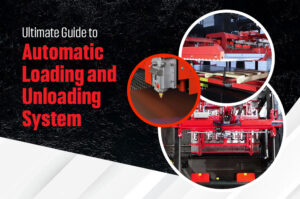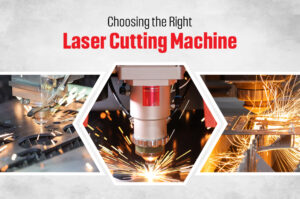Laser cutting technology has revolutionized the way materials are processed, allowing for intricate designs and high-quality products. Among these technologies, fiber laser tube cutting machine play a vital role in producing parts for industries like automotive, construction, aerospace, and medical device manufacturing. While fully automatic tube laser cutting machines are widely used in large-scale operations, semi-automatic tube laser cutting machines provide an accessible alternative for smaller enterprises or those with varying production needs. In this blog, we will explore the details of semi-automatic tube laser cutting machines, compare them with fully automatic machines, and discuss the components, benefits, applications, and maintenance considerations. By the end of this post, you will understand how both types of machines work, their advantages, and how to choose the right one for your business.
 Historical Evolution of Semi-Automatic Machines
Historical Evolution of Semi-Automatic Machines
The journey of tube cutting technology has seen significant advancements. Initially, cutting tubes was entirely manual, requiring high levels of skill and time. Manual methods were labor-intensive and often inconsistent, especially for intricate designs. The introduction of semi-automatic machines revolutionized this process by automating repetitive tasks while allowing operators control over key steps. Semi-automatic machines emerged as a practical solution, providing manufacturers with increased productivity and precision. Compared to fully automatic systems, these machines struck a balance between affordability and efficiency, making them a popular choice for various industries.
The Basics of Tube Laser Cutting
What is Tube Laser Cutting?
Tube and pipe laser cutting machines involves using a laser beam to cut and shape tubes and pipes with high precision. This technology enables manufacturers to cut a variety of materials, including metals such as steel, aluminium, copper, and brass, into complex shapes and profiles. Unlike traditional cutting methods, such as sawing or grinding, tube laser cutting provides smoother cuts, minimal burr formation, and the ability to perform intricate designs that would be impossible with mechanical tools.
There are two main types of tube laser cutting systems:
Semi-Automatic Tube Laser Cutting Machines: These machines combine automation and manual control. While many of the processes, such as cutting and positioning, are automated, the operator still plays an active role in feeding the tube, adjusting settings, and making fine-tuned changes.
Fully Automatic Tube Laser Cutting Machines: Fully automated systems operate with minimal human intervention. These machines perform all functions automatically, including tube loading, cutting, and unloading, often without the need for manual adjustments once the system is set up.
Semi-Automatic vs. Fully Automatic Tube Laser Cutting Machines: A Comparison
| Feature | Semi-Automatic Tube Laser Cutting Machine | Fully Automatic Tube Laser Cutting Machine |
|---|---|---|
| Operator Involvement | High (operator feeds tubes, makes adjustments) | Low (machine handles all tasks automatically) |
| Production Volume | Low to medium | High (designed for large-scale production) |
| Cost | Lower | Higher |
| Flexibility | High (ideal for custom or low-volume work) | Low (best for mass production) |
| Efficiency | Moderate (manual loading) | High (automated tube loading and unloading) |
| Material Handling | Manual (operator handles tubes) | Automatic (machine loads, cuts, and unloads) |
| Maintenance Requirements | Moderate (requires occasional operator adjustment) | Low (fewer manual adjustments needed) |
| Precision | High (laser cutting technology) | Very high (automatic adjustments for precision) |
| Customization | High (operator can adjust cutting parameters) | Low (automated settings for predefined cuts) |
How Semi-Automatic Tube Laser Cutting Machines Work
Key Features of Semi-Automatic Tube Laser Cutting Machines
Semi-automatic tube laser cutting machines offer a combination of precision and flexibility. Below are the key components and features of these systems:
Laser Head: The laser head is the core of the cutting process. It directs the laser beam onto the tube to perform the cut.
Control Panel: The operator uses the control panel to adjust settings such as cutting speed, laser power, and tube alignment. The user interface is typically intuitive, designed to allow easy adjustments during production.
Tube Feeding Mechanism: In semi-automatic machines, the operator manually loads the tube into the machine, but some models automate the alignment process.
Cutting Area: The machine has a dedicated cutting area where the tube is positioned and cut according to the pre-programmed design.
Advantages of Semi-Automatic Tube Laser Cutting Machines
Semi-automatic machines are ideal for businesses that require flexibility and precision without the heavy investment of fully automated systems. Here are the key benefits:
Cost-Effectiveness: Semi-automatic machines are typically more affordable than fully automated machines, making them ideal for small and medium enterprises (SMEs).
Precision: While operators are involved, laser cutting technology ensures a high level of precision, resulting in clean, accurate cuts.
Customization: Semi-automatic systems allow operators to adjust parameters on the fly, making them perfect for custom jobs or low-volume production runs.
Flexibility: The operator’s involvement ensures the machine can handle a wider variety of tube sizes and materials, offering more flexibility in terms of production.
User-Friendly: Semi-automatic machines are designed to be easy to operate, reducing the training time for operators.
What is a Semi-Automatic Tube Laser Cutting Machine?
Key Features
Semi-automatic tube laser cutting machines come with a variety of features designed to simplify operations:
Partial Automation: The machine automates some steps, such as cutting, while leaving alignment and loading tasks to the operator.
Advanced Lasers: High-precision lasers ensure accurate and consistent cuts, even for complex shapes.
Versatility: These machines handle a wide range of tube sizes, materials, and designs.
Compact Design: Semi-automatic systems are typically smaller, making them ideal for workshops with limited space.
Comparison with Fully Automatic Systems
Semi-automatic machines differ significantly from their fully automatic counterparts:
Cost-Effectiveness: Semi-automatic machines are less expensive, making them accessible to smaller manufacturers.
Operator Control: These machines allow manual adjustments, making them suitable for custom projects.
Simpler Maintenance: Fewer automated components reduce the complexity of maintenance, lowering long-term operational costs.
Comparison with Manual Systems
Compared to traditional manual methods, semi-automatic machines:
Reduce Fatigue: Operators experience less physical strain due to the partial automation of tasks.
Improve Accuracy: Laser precision eliminates inconsistencies found in manual cutting.
Enhance Productivity: By speeding up the cutting process, these machines allow manufacturers to meet deadlines with ease.
Key Components of Semi-Automatic and Fully Automatic Tube Laser Cutting Machines
| Component | Semi-Automatic Tube Laser Cutting Machine | Fully Automatic Tube Laser Cutting Machine |
|---|---|---|
| Tube Loading System | Manual loading with operator assistance | Fully automated tube loading |
| Laser Cutting Head | Manual adjustments for cutting parameters | Automatically adjusts focus, power, and speed |
| Control Panel | Operator-controlled for fine adjustments | Pre-programmed settings, minimal adjustments |
| Tube Feeding Mechanism | Semi-automated for alignment | Fully automated alignment and feeding |
| Cutting Path Optimization | Manual control of cutting parameters | Automatically optimized for efficiency |
| Unloading System | Manual unloading by operator | Automatic unloading of finished parts |
| Cooling System | Water or air cooling (manual maintenance) | Water or air cooling with automated monitoring |
Applications of Semi-Automatic Tube Laser Cutting Machines
Semi-automatic machines find applications across various industries:
Automotive: These machines are used to create precision parts such as exhaust systems, roll cages, and structural supports.
Furniture: Perfect for crafting decorative frames and custom designs, ensuring uniform quality.
Construction: Widely used for cutting pipelines, support structures, and brackets.
Aerospace: Ideal for lightweight yet durable tubing used in aircraft manufacturing.
Agriculture: Helps produce durable equipment parts and irrigation systems.
This versatility ensures that semi-automatic machines can cater to diverse manufacturing needs, making them an invaluable asset.
Material Versatility
Semi automatic laser tube cutting machine is capable of processing various materials, including:
Stainless Steel: Perfect for use on industrial and construction projects. Durable and corrosion resistant.
Aluminium: Used widely in automotive and aerospace industries, lightweight, versatile.
Carbon Steel: Robust, affordable and suitable for structural components.
Copper and Brass: Applied for decorative purposes because of their appearance.
The broad range of material compatibility gives the machine its versatility for a variety of production environments.
Advantages of Semi-Automatic Tube Laser Cutting Machines
Cost-Efficiency
An affordable alternative to fully automatic systems is provided by semi automatic machines. Their precision and versatility are similar, but they don’t require the high initial investment in the first place making them a good choice for smaller manufacturers.
Flexibility in Production
In partial automation, operators can use the settings to adapt to specific projects. The machine’s adaptability is suited for short production runs and for unique design.
Ease of Use
Semi automatic systems are easy to use; they require minimum training of operators. The interface is intuitive so the operations will remain smooth even for new users.
Space-Saving Design
These machines are compact and efficient therefore they can fit perfectly into smaller workshops and make the most of the available workspace.
Energy Efficiency
Fully automatic machines are energy intensive, whereas semi automatic machine consumes less energy thus reducing the overall operational costs.
Challenges and Limitations
While semi-automatic machines are versatile and efficient, they do come with certain limitations:
Operator Dependency: Manual loading, alignment and other adjustments are required of skilled operators.
Limited Throughput: Because their processing speed is slower, they may not be good for large scale runs.
Complex Designs: More sophisticated patterns may require additional operator expertise or a fully automatic process.
This understanding of these challenges allows manufacturers to integrate these machines into their production workflows effectively.
Customization Opportunities
Semi-automatic machines often allow for customization, enabling manufacturers to tailor the machine’s functionality to their specific needs:
Adjustable Settings: Operators can change a parameter, diameter or cutting speed for a given material.
Modular Add-Ons: With additional tools, such as rotary attachments, machines can be equipped with additional tools.
Advanced Software: Others include software options for pre programmed cuts, which make things even easier.
The flexibility of the machine means it is able to accommodate a variety of manufacturers’ needs.
Maintenance and Care for Tube Laser Cutting Machines
Routine Maintenance for Semi-Automatic Machines
Regular Cleaning: Cleaning is essential so that no debris builds around the laser head to ensure the machine’s performance.
Laser Alignment: The cutting performance may be optimized if the laser alignment is checked periodically.
Component Inspection: Moving parts and the cooling system will be regularly inspected and the machine will last longer.
Routine Maintenance for Fully Automatic Machines
Software Updates: Advanced software operation of fully automated systems that rely on the software for operation dictates routine updates and calibrations.
Automatic Lubrication: According to these systems, there is an automatic lubrication mechanism to lower the friction and moving parts of these systems.
System Diagnostics: Performance and potential issues can be monitored automatically and be detected prior to affecting production using automatic self check systems.
Conclusion
Demands of the production, budget and the volume of the production are the bases for making the right decision on whether to go for a semi automatic tube laser cutting machine or go for a fully automatic tube laser cutting machine. Flexibility, precision and cost effectiveness make semi automatic systems ideal for smaller to medium enterprises or custom production jobs. However, fully automatic systems offer much better speed, consistency and little worker involvement, and therefore are suitable for high volume, mass production. At Business Point International, we are proud to stock a wide variety of tube laser cutting machines that are designed to service the varied needs of manufacturers in various industries. We have semi automatic and fully automatic machines fit for exceptional performance and reliability. Contact us today to see how our state of the art machines can supercharge your production processes.















